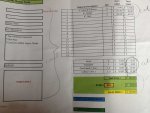infinite2006
Registered User.
- Local time
- Today, 14:49
- Joined
- Jun 20, 2013
- Messages
- 16
using Access 2010
Hi guys,
My aim is to create a customer price quotation form and accompanying report for printing the customer quote. Thus far I’ve created two tables with a one to many relationship (one customer can have many orders). Please see attached. I think this part is sound although a more efficient design may have called for a third table.
My thinking is that if I create a query that pulls in all the fields then I can use this query to build a solid form for producing customer quotations. One of the fields (markup %) is parameter based so it will prompt the user to enter a percentage markup in order to calculate the sales price based on the cost price, for example 10, 20% etc. I think I’ve got this part working also, please see the query design and output, but not sure if the prompt will be generated when I build the form from the query?
Question 1: Am I on the right track in terms of building a form from the above query, does this make sense? If not, ignore question 2, it’s irrelevant and back to the drawing board.
Question 2: I would like to be able to sum/total each INDIVIDUAL customer order. Presently I cannot get this working, when I add totals to the query or ‘group by’, the total of ALL customer orders is presented. Is my table design totally flawed, what silly mistake am I making?
Question 3: Can anyone shed some light on the above in relation to generating a report from this form, perhaps this is where the group by is best placed?
Many thanks,
Infinite
Hi guys,
My aim is to create a customer price quotation form and accompanying report for printing the customer quote. Thus far I’ve created two tables with a one to many relationship (one customer can have many orders). Please see attached. I think this part is sound although a more efficient design may have called for a third table.
My thinking is that if I create a query that pulls in all the fields then I can use this query to build a solid form for producing customer quotations. One of the fields (markup %) is parameter based so it will prompt the user to enter a percentage markup in order to calculate the sales price based on the cost price, for example 10, 20% etc. I think I’ve got this part working also, please see the query design and output, but not sure if the prompt will be generated when I build the form from the query?
Question 1: Am I on the right track in terms of building a form from the above query, does this make sense? If not, ignore question 2, it’s irrelevant and back to the drawing board.
Question 2: I would like to be able to sum/total each INDIVIDUAL customer order. Presently I cannot get this working, when I add totals to the query or ‘group by’, the total of ALL customer orders is presented. Is my table design totally flawed, what silly mistake am I making?
Question 3: Can anyone shed some light on the above in relation to generating a report from this form, perhaps this is where the group by is best placed?
Many thanks,
Infinite

